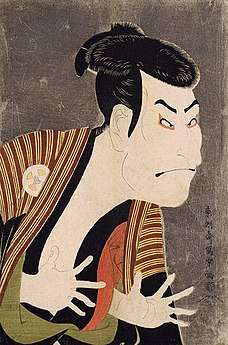Kirazuri
Kirazuri (雲母摺り) is one of the printing methods in Ukiyoe printmaking using mica powder, or 雲母 (kira). When it is used for the background in portraits, and depending on the base color, it is called Shiro-kirazuri (white), Kuro-kirazuri (literally black, but dark gray practically), and Beni-kirazuri (red).[2]
_Arashi_Ry%C5%ABz%C5%8D_I_as_Yakko_Ukiyo_Matabei_and_%C5%8Ctani_Hiroji_III_as_Yakko_Tosa_no_Matabei_(compressed).jpg)
_Naniwaya_O-Kita.jpg)

Types
There are several different types of Kirazuri.
“Surikira”, (摺り雲母) which is a printing method where mica is mixed into the printing ink. Mineral paints are diluted with water and gelatin as binding, and put on the printing woodblock for background coloring.[3]
"Makikira" (撒き雲母) where very fine mica peppers are applied on paper using a sprinkling tool. While adhesive brushed onto paper surface is still wet, mica is shaken over it and attaches to it. Unfixed mica is removed with brush strokes after the paper dries.[3]
For ”Okikira” (置き雲母), you will paint the design with a mixture of mica and glue on brush, and the glue functions as a thickening agent to give texture to brush strokes.[3]
Features
Kira literally means sparkling. Imagine a glitter sticker. However, you can only see the sparkle by picking it up and moving it, or tilting the painting to reflect light as with picture b) and picture c). If you don't move it, you'll only see the ink color, or gray in case of kuro-kirazuri as in picture a).[4]
Further reading
- Tokyo National Museum, ed. (2011). SHARAKU an Exhibition Catalogue (PDF) (in Japanese and English). Tokyo: TNM, Tokyo Shinbun, NHK, NHK Promotions. OCLC 741956613. Retrieved November 27, 2019.
References
- TNM 2011.
- World Encyclopedia Second Edition (CD-ROM) (in Japanese). Japan: Hitachi digital Heibon-sha. 1998.
- "Ukiyo-e print technique that is not transmitted in the catalog". ARTISTIAN. Retrieved 12 November 2019.
- "The world of appreciating ukiyo-e with single glasses". VIXEN (in Japanese). Retrieved 12 November 2019.